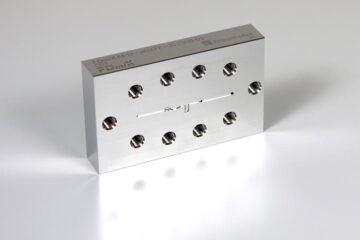Tug-of-cell war

Researchers at the School of Life Sciences, University of Dundee have made an exciting new discovery on how cells regulate themselves and prevent cancer as reported in Nature tomorrow (Wednesday). Dr Tomo Tanaka and his team members, Drs Hilary Dewar and Kozo Tanaka have uncovered a tug of war that cells use to collect their full complement of correct chromosomes. The absence of this tug of war leads to irregular cells, tumours, cancer and congenital disorders such as Down syndrome.
How all daughter cells get all their chromosomes has until now been a mystery. But now that the team know how cells collect their vital information, they can explore how cells prevent cancers and other diseases by ensuring proper chromosome inheritance during cell division.
All human cells (except eggs and sperms) contain 46 chromosomes, all of which carry vital genetic information. Because genetic information is crucial for the proper function of cells for the organs and tissues that they organise, all chromosomes must be precisely copied and separated into two daughter cells during each cell division.
Dr Tanaka says: “As a cowboy catches a wild horse by his lasso, each daughter cell captures chromosomes by a rope-like apparatus and then drags them to her side before she finally divides from her sister. Our data suggest that cells are able to know if they have captured the right chromosomes or not by playing a tug-of-war game for them. This game is possible because duplicated chromosomes still attach to each other when they are captured by ropes. If cells do not feel a tug, they realise that they have grabbed the wrong chromosomes. In this case, daughter cells have to throw another rope toward a chromosome and repeat this process until they capture the right one.”
The research team has also identified an enzyme called Aurora as a key regulator whose activity allows daughter cells to have this second trial. Research has shown that if Aurora activity goes wrong, cancers could occur.
Dr Lesley Walker, Director of Cancer Information, Cancer Research UK says: “This work sheds light on how dividing cells ensure that the genetic material is shared evenly between their daughter cells. By understanding how healthy cells work, we can gain considerable insight into what goes wrong in cancer. Thus world-class research like this is crucial for increasing our understanding of the biology of cancer, and could ultimately pave the way for new approaches to prevent and treat the disease.”
Dr Tomo Tanaka is a Wellcome Trust Career Development Fellow and Principal Investigator in the Division of Gene Regulation and Expression based in the Wellcome Trust Biocentre at the University of Dundee.
The research is funded by The Wellcome Trust and Cancer Research UK.
The study, entitled “Tension between two kinetochores suffices for their bi-orientation on the mitotic spindle” is published by Nature (online) on 11 February.
Media Contact
More Information:
http://www.dundee.ac.uk/pressreleases/prfeb04/tugcell.htmlAll latest news from the category: Life Sciences and Chemistry
Articles and reports from the Life Sciences and chemistry area deal with applied and basic research into modern biology, chemistry and human medicine.
Valuable information can be found on a range of life sciences fields including bacteriology, biochemistry, bionics, bioinformatics, biophysics, biotechnology, genetics, geobotany, human biology, marine biology, microbiology, molecular biology, cellular biology, zoology, bioinorganic chemistry, microchemistry and environmental chemistry.
Newest articles

For microscopic organisms, ocean currents act as ‘expressway’ to deeper depths
New research shows how tiny plant-like organisms hitch a ride on ocean currents to reach darker and deeper depths, where they impact carbon cycling and microbial dynamics in the subtropical…

FDmiX: Fast, robust series production of nanoparticles
Nucleic acid-based medications such as mRNA vaccines are opening up new therapeutic approaches. These active ingredients must be enclosed inside nanoparticles to ensure that they get to where they are…

Sensor measures oxygen content of breath
Oxygen saturation in the blood that is either too low or too high can cause physical harm or even death. This is why patients’ oxygen concentraions are monitored continuously in…





















